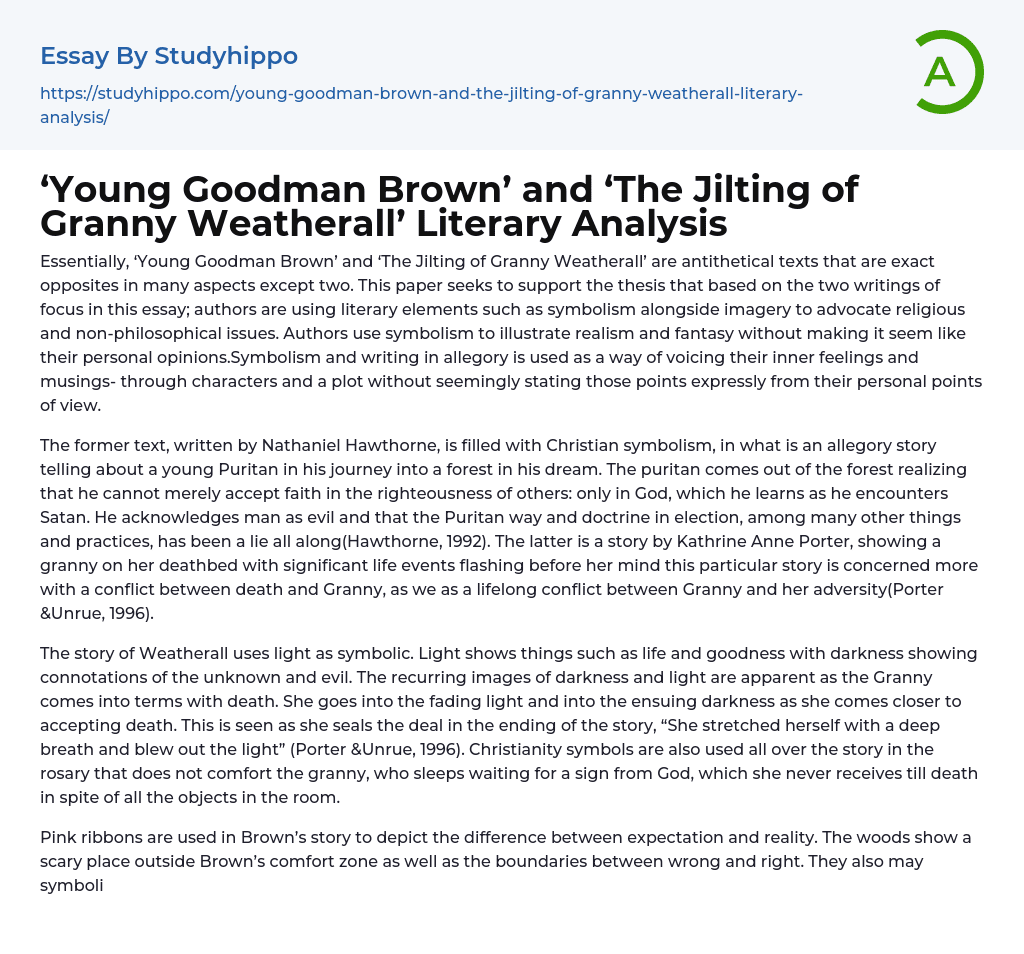

‘Young Goodman Brown’ and ‘The Jilting of Granny Weatherall’ Literary Analysis Essay Example
Essentially, ‘Young Goodman Brown’ and ‘The Jilting of Granny Weatherall’ are antithetical texts that are exact opposites in many aspects except two. This paper seeks to support the thesis that based on the two writings of focus in this essay; authors are using literary elements such as symbolism alongside imagery to advocate religious and non-philosophical issues. Authors use symbolism to illustrate realism and fantasy without making it seem like their personal opinions.Symbolism and writing in allegory is used as a way of voicing their inner feelings and musings- through characters and a plot without seemingly stating those points expressly from their personal points of view.
The former text, written by Nathaniel Hawthorne, is filled with Christian symbolism, in what is an allegory story telling about a young Puritan in his journey into a f
...orest in his dream. The puritan comes out of the forest realizing that he cannot merely accept faith in the righteousness of others: only in God, which he learns as he encounters Satan. He acknowledges man as evil and that the Puritan way and doctrine in election, among many other things and practices, has been a lie all along(Hawthorne, 1992). The latter is a story by Kathrine Anne Porter, showing a granny on her deathbed with significant life events flashing before her mind this particular story is concerned more with a conflict between death and Granny, as we as a lifelong conflict between Granny and her adversity(Porter &Unrue, 1996).
The story of Weatherall uses light as symbolic. Light shows things such as life and goodness with darkness showing connotations of the unknown and evil. The recurring images of darkness and light are apparent as
the Granny comes into terms with death. She goes into the fading light and into the ensuing darkness as she comes closer to accepting death. This is seen as she seals the deal in the ending of the story, “She stretched herself with a deep breath and blew out the light” (Porter &Unrue, 1996). Christianity symbols are also used all over the story in the rosary that does not comfort the granny, who sleeps waiting for a sign from God, which she never receives till death in spite of all the objects in the room.
Pink ribbons are used in Brown’s story to depict the difference between expectation and reality. The woods show a scary place outside Brown’s comfort zone as well as the boundaries between wrong and right. They also may symbolize the embodiment of Brown’s fears as well as suspicions of the dark feelings he fails to acknowledge. The evil tries to take him away from the faith he knows: the same faith he does not find as comforting upon his return (Hawthorne, 1992).
On one hand, Kathrine writes her story in what can be seen to be a complaint against betrayal, against anonymity, as well as against mighty powers abandoning those that have been relying on them. In her text, the celebration of triumph can be seen in the statement Granny makes when she says that she got her house, her children, and her husband in similar fashion- like other women, without George! On the other hand, Nathaniel writes the story of ‘Young Goodman Brown’ as a moral lesson in regards to the underlying religious fanaticism that has been shown by the Puritans in
the story as much as fanaticism does not stop with the Puritans. The celebration of triumph in Nathaniel’s story is seen against all-pervading evil that has been disguised as righteousness in the young man that the author depicts as willing to resist the ‘devil’ at all costs. The contrast is seen as the Granny complains against the anonymity of the mighty powers as well as the abandonment of the people by these mighty powers that they rely on.
The similarity in the two stories is that Brown and Weatherall come face to face with unsuspected traits in their loved ones although the qualities in the surprising traits are not comparable. Weatherall encounters weakness and cowardice whereas Brown encounters evil that is all-pervasive. Furthermore, as much as the two characters do not have similar encounters in the unsuspected traits they come across, their names alone are points that distinguish the differences in their stories. Weatherall shows just wat the name suggests- a granny that can weather almost all. On the other hand, Brown is muddied, stirred, darkened as well as a one shade above dejection.
The symbolism that is illustrated in the final moments on earth in both stories as both brown and Granny are not happy. Browns happiness spans over his entire lifetime whereas for Weatherall, who has weathered a lot, the moment comes down to his last moments on earth. Brown discovers earlier that the world he lived in was full of lies and religious hypocrisy. On the other hand, Weatherall feels betrayal, rejection, and anger in her last breaths. She should have known better than to seek a miracle from God in the last minute
as a Christian bearing in mind that eternal life is guaranteed after death, so the disillusionment can be seen as her fault. The symbolism in her name is ironic in this sense in the same way the anger and disillusion were mere projections of feelings she inhibited throughout her life of betrayal from the almighty being she believed in.
References
- Hawthorne, N. (1992). Young Goodman Brown, and other short stories. New York: Dover
Publications. - Porter, K. A., &Unrue, D. H. (1996). Katherine Anne Porter's poetry. Columbia, SC: Univ. of
South Carolina Press.



